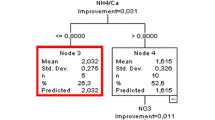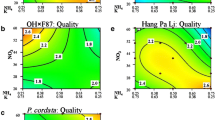Abstract
A response surface methodology (RSM) experimental design was applied for improving micropropagation of a wild apricot, Prunus armeniaca Lam., from the mountains of Kazakhstan. In an initial study, woody plant medium (WPM) mineral nutrients [calcium nitrate, ammonium nitrate, mesos (calcium chloride, potassium phosphate and magnesium sulfate) potassium sulfate and minor nutrients] were tested in a response surface methodology (RSM) experiment. Shoot quality was the best when nitrogen and mesos (CaCl2, MgSO4, K2SO4, KH2PO4) compounds were altered. In this study an expanded mesos optimization experiment was run. Data taken included a subjective quality rating, shoot length, shoot number, leaf color and size, callus and physiological disorders. Data were analyzed by Classification and Regression Tree Analysis (CART), a data mining technique that provides specific cutoff values for data and easy to interpret data trees. The CART analysis indicated that the best quality would be with ≤2.4× WPM levels of KH2PO4 and ≤0.75× MgSO4. Shoot length was affected by K2SO4, but most shoots were of good size at any concentration. Shoot multiplication was affected by KH2PO4, but there were >5 shoots at any concentration. Leaf color was best with ≤2.41× KH2PO4 and ≤1.22× K2SO4. Based on the CART analysis, a recommendation for improved mesos compounds was developed. Each of the individual trees was analyzed and the cutoff points determined so that all the growth characteristics could be considered in the final concentrations chosen. Using the combined results from the CART analysis, the suggested medium would include WPM with CaCl2 2.7×, MgSO4 2.7×, K2SO4 0.8×, KH2PO4 0.75×.









Similar content being viewed by others
References
Akin M (2016) Statistical methods for tissue culture medium optimization and a multiplexed fingerprinting set for hazelnuts. Dissertation, Oregon State University, Corvallis
Akin M, Eyduran E, Reed BM (2016) Use of RSM and CHAID data mining algorithm for predicting mineral nutrition of hazelnut. Plant Cell Tiss Organ Cult. doi: 10.1007/s11240-016-1110-6
Alanagh E, Garoosi GA, Haddad R, Maleki S, Landín M, Gallego P (2014) Design of tissue culture media for efficient Prunus rootstock micropropagation using artificial intelligence models. Plant Cell Tiss Organ Cult 117(3):349–359. doi:10.1007/s11240-014-0444-1
Ali M, Eyduran E, Tariq MM, Tirink C, Abbas F, Bajwa MA, Baloch MH, Nizamani AH, Waheed A, Awan MA, Shah SH, Ahmad Z, Jan S (2015) Comparison of artificial neural network and decision tree algorithms used for predicting live weight at post weaning period from some biometrical characteristics in Harnai sheep. Pak J Zool 47(6):1579–1585
Anderson MJ, Whitcomb PJ (2005) RSM simplified: optimizing processes using response surface methods for design of experiments. Productivity Press, New York
Design-Expert (2010) Stat-Ease, Inc., Minneapolis, MN
Driver JA, Kuniyuki AH (1984) In vitro propagation of Paradox walnut rootstock. HortScience 19:507–509
Gago J, Perez-Tornero O, Landin M, Burgos L, Gallego PP (2011) Improving knowledge of plant tissue culture and media formulationby neurofuzzy logic: a practical case of data mining using apricot databases. J Plant Physiol 168(15):1858–1865
Hand CR, Maki S, Reed BM (2014) Modeling optimal mineral nutrition for hazelnut (Corylus avellana) micropropagation. Plant Cell Tiss Organ Cult 119:411–425. doi:10.1007/s11240-014-0544-y
Kovalchuk I, Mukhitdinova Z, Turdiyev T, Reed B (2017) Optimization of WPM for a wild Kazakhstan Apricot, Prunus armeniaca. Acta Hortic (in press)
Lloyd G, McCown B (1980) Commercially feasible micropropagation of mountain laurel, Kalmia latifolia, by use of shoot-tip culture. Comb Proc Int Plant Prop Soc 30:421–427
Lopez-Lefebre LR, Rivero RM, Garcia PC, Sanchez E, Ruiz JM, Romero L (2001) Effect of calcium on mineral nutrient uptake and growth of tobacco. J Sci Food Agric 81:1334–1338
Marino G, Bertazza G, Magnanini E, Altan AD (1993) Comparative effects of sorbitol and sucrose as main carbon energy sources in micropropagation of apricot. Plant Cell Tiss Organ Cult 34(3):235–244. doi:10.1007/bf00029712
Murashige T, Skoog F (1962) A revised medium for rapid growth and bio assays with tobacco tissue cultures. Physiol Plant 15:473–497
Niedz RP, Evens TJ (2007) Regulating plant tissue growth by mineral nutrition. In Vitro Cell Dev Biol-Plant 43:370–381.
Niedz RP, Hyndman SE, Evens TJ (2007) Using a gestalt to measure the quality of in vitro responses. Sci Hortic 112(3):349–359
Nisbet R, Elder J, Miner G (2009) Handbook of statistical analysis and data mining applications. Academic Press, London
Pérez-Tornero O, Burgos L (2000) Different media requirements for micropropagation of apricot cultivars. Plant Cell Tiss Organ Cult 63:133–141
Pérez-Tornero O, Burgos L (2007) Apricot micropropagation. In: Jain SM, Häggman H (eds) Protocols for micropropagation of woody trees and fruits. Springer Netherlands, Dordrecht, pp 267–278
Poothong S, Reed BM (2014) Modeling the effects of mineral nutrition for improving growth and development of micropropagated red raspberries. Sci Hortic 165(0):132–141
Quoirin M, Lepoivre P (1977) Improved media for in vitro culture of Prunus sp. Acta Hortic 78:437–442
Rashidi S, Ranjitkar P, Hadas Y (2014) Modeling bus dwell time with decision tree-based methods. Transp Res Rec: J Trans Res Board 2418:74–83
Reed BM, Wada S, DeNoma J, Niedz RP (2013) Improving in vitro mineral nutrition for diverse pear germplasm. In Vitro Cell Dev Biol-Plant 49:343–355
SPSS (2013) Statistics for Windows, Version 22.0. IBM Corp, Armonk, NY
Wada S, Niedz RP, Reed BA (2015) Determining nitrate and ammonium requirements for optimal in vitro response of diverse pear species. In Vitro Cell Dev Biol-Plant 51:19–27
Yordanova A, Gocheva-Illieva S, Kulina H, Yordanova L, Marinov I (2015) Classification and regression tree analysis in modeling the milk yield and conformation traits for Holstein cows in Bulgaria. J Animal Sci Technol 7(2):208–213
Acknowledgements
This study was funded by ISTC project K-1920 and USDA-ARS CRIS project 5358-21000-038-00D.
Author contributions
IK assisted with planning the study, supervised the work and assisted in writing the manuscript. ZM, TT and GM set up and ran the experiments and collected data. MA assisted with data analysis and writing the manuscript. EE assisted with data analysis. BMR assisted with planning the study, set up the experimental design, assisted with data analysis and writing the manuscript.
Author information
Authors and Affiliations
Corresponding author
Rights and permissions
About this article
Cite this article
Kovalchuk, I.Y., Mukhitdinova, Z., Turdiyev, T. et al. Modeling some mineral nutrient requirements for micropropagated wild apricot shoot cultures. Plant Cell Tiss Organ Cult 129, 325–335 (2017). https://doi.org/10.1007/s11240-017-1180-0
Received:
Accepted:
Published:
Issue Date:
DOI: https://doi.org/10.1007/s11240-017-1180-0




